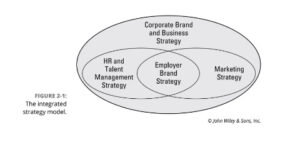The Employer Branding Handbook: Creating a Positive Reputation and a High-Performing Team
Employer branding has become an increasingly important aspect of HR management, as companies compete to attract and retain top talent in a highly competitive job market. A strong employer brand can help to differentiate your company from competitors, attract the right candidates, and create a positive workplace culture. In this article, we will explore strategies for building a strong employer brand based on research and practical advice from experts in the field.
Defining Your Employer Brand
The first step in building a strong employer brand is to define what makes your company unique. This involves understanding your company culture, values, and mission, and how these align with the needs and expectations of your target audience. According to Richard Mosley, author of “Employer Branding for Dummies” and “Employer Branding and the Employee Lifecycle,” your employer brand should be based on three key elements: differentiation, relevance, and authenticity.
To differentiate your company from competitors, you need to identify what makes your company unique and highlight these qualities in your employer brand. For example, if your company has a strong commitment to sustainability, you can highlight this in your messaging and recruitment strategies to attract candidates who share this value.
Relevance means understanding the needs and preferences of your target audience and shaping your employer brand to meet these needs. For example, if you are targeting millennials, you may want to focus on work-life balance, flexible scheduling, and opportunities for career growth and development.
Authenticity means being true to your company culture, values, and mission. This means not only promoting the positive aspects of your company, but also being transparent about any challenges or areas for improvement. This helps to build trust with potential candidates and creates a positive reputation for your company.
Leveraging Your Existing Employees
One of the most powerful resources for building a strong employer brand is your existing employees. According to Laura K. Meister and Kelly Monahan, authors of “The role of employer branding in the war for talent,” employees can be “brand ambassadors” who help to promote your company culture and values through social media and other channels.
To leverage your existing employees, you can encourage them to share their experiences and success stories on social media platforms like LinkedIn, Instagram, and Facebook. You can also provide them with training and development opportunities that help them to grow professionally and become more engaged with your company.
Building a Strong Online Presence
In today’s digital age, having a strong online presence is essential for building a strong employer brand. This means having a well-designed and informative company website, as well as active social media profiles that showcase your company culture, values, and mission.
To build a strong online presence, you should focus on creating content that is engaging, informative, and relevant to your target audience. This can include blog posts, videos, and social media updates that highlight your company’s unique qualities and values. You should also engage with your followers and respond to their comments and queries promptly to build a positive reputation for your company.
Investing in Employee Development
Investing in employee development is another key strategy for building a strong employer brand. This means providing your employees with training and development opportunities that help them to learn new skills, take on new challenges, and grow professionally.
According to Rachel I. Richardson and J. Scott Armstrong, authors of “Building a Strong Employer Brand: A Case Study of the University of Warwick,” investing in employee development can help to retain existing employees and attract new talent who want to work for a company that values their professional growth.
Creating a Positive Candidate Experience
Finally, creating a positive candidate experience is essential for building a strong employer brand. This means providing clear communication, a timely and efficient recruitment process, and a positive impression of your company culture and values throughout the recruitment process.
According to a study by CareerArc, 60% of job seekers have had a poor candidate experience, and this can have a negative impact on your employer brand. To create a positive candidate experience, you should:
Communicate clearly and promptly with candidates throughout the recruitment process, including providing regular updates on the status of their application.
Be respectful and professional in all interactions with candidates, including during interviews and in follow-up communications.
Provide a realistic preview of your company culture and values throughout the recruitment process, including through job descriptions, employee testimonials, and site visits if possible.
By creating a positive candidate experience, you can help to attract top talent and build a positive reputation for your company.
The Importance of Employer Branding
According to a study by LinkedIn, companies with strong employer brands have a 43% lower cost per hire and a 28% lower turnover rate compared to companies with weak employer brands. This shows that investing in employer branding can lead to significant benefits for organizations in terms of talent acquisition and retention.
Moreover, in a study by Universum, 90% of students and young professionals say that they would consider an employer’s brand before applying for a job. This highlights the importance of employer branding in attracting the next generation of talent. Google has been recognized as one of the most attractive employers globally due to its unique and employee-friendly work environment.
Google’s Employer Brand
The company has consistently invested in employer branding to attract and retain top talent. The Chief of Development Employer Strategy at Google was Kyle Ewing. Ewing has been with Google since 2007 and has held various HR leadership roles, including leading HR for the sales organization and leading global mobility and immigration. In her current role, Ewing is responsible for driving Google’s global employer brand strategy and employee engagement initiatives.
Google is known for its innovative and employee-friendly work environment. The company’s employer brand focuses on promoting its values of creativity, collaboration, and continuous learning.
Google’s communication strategy includes its website, social media channels, and various events and initiatives that promote its employer brand. The company also involves its employees in the branding process by encouraging them to share their experiences through social media and internal communication channels.
Google measures the effectiveness of its employer brand through various metrics, including employee retention and satisfaction rates. Employee retention refers to the percentage of employees who remain with the company over a specific period. High retention rates indicate that employees are satisfied with their jobs and the company’s work environment. Google uses employee retention rates as a measure of the effectiveness of its employer brand because it shows how well the company is able to attract and retain top talent.
Employee satisfaction rates, on the other hand, refer to the percentage of employees who report being satisfied with their jobs and the company. Google regularly conducts employee surveys to measure employee satisfaction levels. The company also tracks employee feedback through various channels such as Glassdoor reviews, employee engagement surveys, and one-on-one meetings. Google also measures the effectiveness of its employer brand through other metrics such as:
- Applicant tracking: Google tracks the number of job applicants it receives and their quality to measure the effectiveness of its employer brand in attracting top talent.
- Social media engagement: Google measures the engagement levels on its social media channels, such as likes, shares, and comments, to gauge the effectiveness of its employer brand messaging.
- Brand recognition: Google measures the level of brand recognition it has among job seekers to assess the effectiveness of its employer brand strategy.
Example: In 2020, Google was ranked number one on Fortune’s list of Best Companies to Work For. This ranking was based on several factors, including employee satisfaction, retention rates, and benefits offered. Google’s high ranking is an example of how the company’s employer branding strategy has been effective in attracting and retaining top talent. Additionally, the company’s high retention rates and positive employee feedback on platforms such as Glassdoor are indicators of the effectiveness of Google’s employer branding strategy. The company regularly updates its employer brand to ensure that it remains relevant and effective.
Google’s employer branding strategy includes the following:
- Promoting its values: Google’s employer branding strategy focuses on promoting its values of innovation, collaboration, and continuous learning. The company showcases its commitment to these values through its work environment, employee benefits, and corporate social responsibility initiatives.
- Providing an exceptional work environment: Google provides its employees with a fun, supportive, and creative work environment. The company’s campuses are designed to foster collaboration and creativity, and employees are provided with various amenities such as free food, fitness centers, and onsite healthcare.
- Encouraging employee empowerment: Google empowers its employees to take ownership of their work and provides them with the freedom to pursue their passions. The company encourages its employees to think creatively and provides them with various opportunities for personal and professional growth.
- Engaging with the community: Google actively engages with the community through its various corporate social responsibility initiatives. The company promotes environmental sustainability, social justice, and education, among other causes.
Conclusion
Building a strong employer brand is essential for attracting and retaining top talent in today’s highly competitive job market. By defining your employer brand, leveraging your existing employees, building a strong online presence, investing in employee development, and creating a positive candidate experience, you can differentiate your company from competitors and create a positive workplace culture that attracts and retains the best talent.
References:
Ambler, T., & Barrow, S. (1996). The employer brand. Journal of Brand Management, 4(3), 185-206.
Iles, P., & Yolles, M. (2010). Employer branding and the contemporary career. Journal of Brand Management, 18(2), 93-101.
Klienman, M., & McDonald, S. (2017). Employer branding and talent management in the luxury sector. Journal of Business Research, 70, 357-365.
Meister, L. K., & Monahan, K. (2014). The role of employer branding in the war for talent. Journal of Brand Strategy, 3(1), 20-30.
Mosley, R. (2017). Employer Branding and the Employee Lifecycle. Wiley.
Mosley, R. (2017). Employer Branding for Dummies. Wiley.
Richardson, R. I., & Armstrong, J. S. (2018). Building a strong employer brand: A case study of the University of Warwick. International Journal of Forecasting, 34(4), 820-827.







